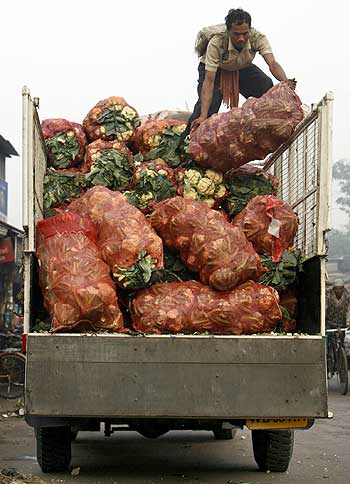 | « Back to article | Print this article |
No respite: Food inflation rockets to 9.90%
Food inflation surged to a four-and-a-half month high of 9.90 per cent during the week ended July 30 on the back of costlier onions, fruits, vegetables and protein-based items.
Food inflation, as measured by Wholesale Price Index (WPI), stood at 8.04 per cent in the previous week. The rate of price rise in food items was recorded at 16.45 per cent in the last week of July, 2010.
As per data released by the government on Thursday, prices of onions went up by 36.62 per cent year-on-year, while fruits became 16.49 per cent more expensive.
Click NEXT to read on . . .
No respite: Food inflation rockets to 9.90%
During the week under review, vegetables overall became dearer by 14.61 per cent and prices of eggs, meat and fish were up by 13.44 per cent on an annual basis. In addition, cereal prices went up by 6.22 per cent, potatoes by 10.85 per cent and milk by 10.38 per cent.
However, pulses became cheaper by almost 6 per cent on an annual basis.
The latest numbers are likely to put further pressure on the government and the Reserve Bank, who have been battling the high rate of price rise over a period of of one-and-a-half years.
Click NEXT to read on . . .
No respite: Food inflation rockets to 9.90%
This is the highest rate of price rise in food items since the week ended March 12, when food inflation stood at 10.05 per cent.
Overall, primary articles recorded inflation of 12.22 per cent for the week ended July 30, up from 10.99 per cent in the previous week. Primary articles have a share of over 20 per cent in the WPI.
However, inflation in non-food articles, which include fibres, oil seeds and minerals, fell to 15.05 per cent from 15.60 per cent in the previous week.
Click NEXT to read on . . .
No respite: Food inflation rockets to 9.90%
Meanwhile, fuel and power inflation stood at 12.19 per cent for the week ended July 30, marginally up from 12.12 per cent in the week ended July 23.
Food inflation was in double digits for most of 2010, but had started to moderate since March this year.
It fell to a 20-month low of 7.33 per cent in mid-July, but the rate of price rise of food items has been on the rise ever since.
Headline inflation stood at 9.44 per cent in June. The RBI has already hiked interest rates 11 times since March, 2010, to tame demand and curb inflation.
Click NEXT to read on . . .
No respite: Food inflation rockets to 9.90%
In its Economic Outlook for 2011-12 released earlier this month, the Prime Minister's Economic Advisory Council projected headline inflation to remain high at around 9 per cent till October. The rate of price rise will ease from November, declining to around 6.5 per cent by March 2012, it said.
The report also said that while pressure from food inflation has fallen in recent months, the rate of price rice still remains quite high, with the possibility of a further surge in coming months.
Earlier this week, the government informed the Parliament that demand-supply mismatches were responsible for the current inflationary situation in the country.




